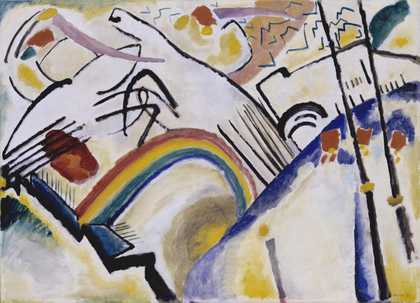In her seminal essay ‘Grids’, the art historian Rosalind Krauss claimed that ‘the grid functions to declare the modernity of modern art’.1 ‘By “discovering” the grid’, Krauss continues, ‘cubism, de Stijl, Mondrian, Malevich … landed in a place that was out of reach of everything that went before. Which is to say, they landed in the present, and everything else was declared to be the past’.2 In the first part of this essay I should like to begin filling up the space of Krauss’s omission points which she placed after Malevich’s name, and thus unravel a trajectory of the function of the grid in twentieth-century Russian art.
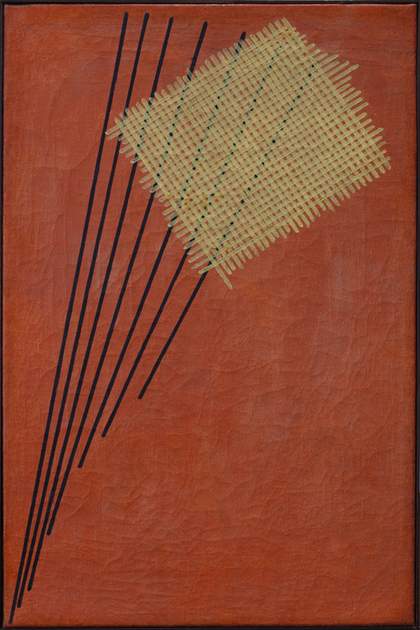
Fig.1
Aleksandr Rodchenko
Construction no.95 1919
Oil on canvas
64.5 x 40 cm
Collection Otten © A. Rodchenko & V. Stepanova Archive, DACS 2009
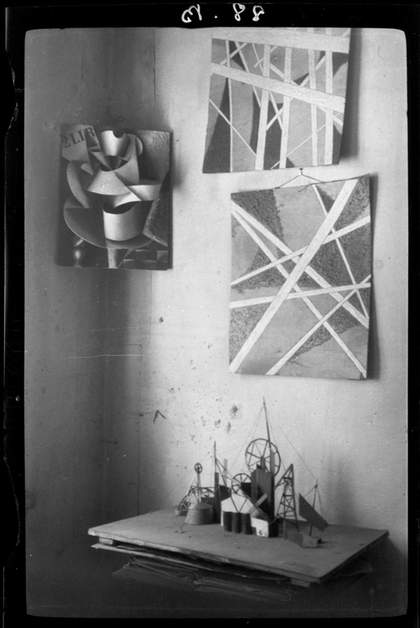
Fig.2
Aleksandr Rodchenko
Popova’s Studio 1924
Gelatin silver print
25 x 16.5 cm
© A. Rodchenko & V. Stepanova Archive, DACS 2009
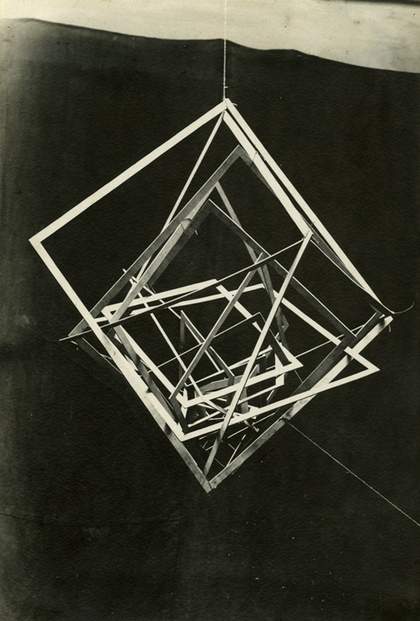
Fig.3
Aleksandr Rodchenko
Hanging Spatial Construction no.11 (Square in Square) c.1921
Gelatin silver print
15.6 x 11.7 cm
© A. Rodchenko & V. Stepanova Archive, DACS 2009
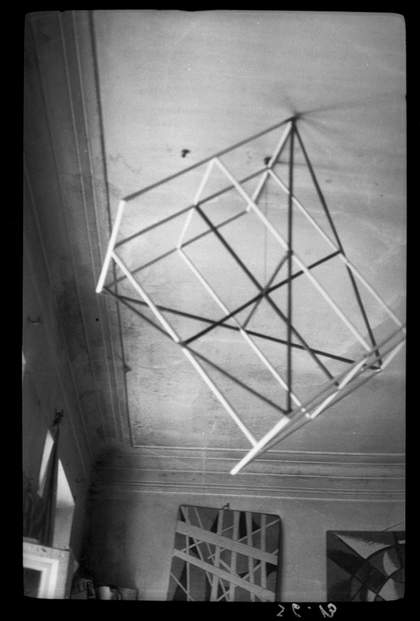
Fig.4
Aleksandr Rodchenko
Popova’s Studio 1924
Gelatin silver print
25 x 16.5 cm
© A. Rodchenko & V. Stepanova Archive, DACS 2009
Technically speaking, Malevich’s eidetic suprematism relied on the intersection of planes rather than lines (the main operative tool of the grid) and is less relevant to the genealogy of this emblematic modernist structure than Aleksandr Rodchenko’s and Liubov Popova’s constructivist paintings (figs.1 and 2) and their sculptural sequels called ‘spatial constructions’ (figs.3 and 4). Rodchenko derived his painting grids from his radical and stylistically diverse architectural drawings made between 1919 and 1920 when briefly a member of the Zhivskul’ptarkh.3 While some drawings relied on planar compositions, expressed at the same time in his non-objective paintings, other proposed models of socialist urban spaces imitated the steel grids of skyscrapers. Post-Revolution economic hardship and political instability prevented Rodchenko and his Zhivskul’ptarkh colleagues from realising most of their architectural projects. The latter were further delayed by the architects’ commitment to study and adopt the principles of modernist painting that had shifted theoretical debates, continued in the newly formed Institute of Artistic Culture (INKhUK), surrounding two-dimensional art. In this context Rodchenko decided to introduce the grid into his last series of paintings, and identify the line as ‘the new’ and, more importantly, ‘the last form of the non-objective art’.4 In her paintings of the same period Popova similarly demonstrated architectural aspirations. Launched after the infamous 0.10 exhibition of 1915, and united under the title Painterly Architectonics, the paintings adapted Malevich’s pictorial vocabulary but added greater tangibility. The tension between the aggressively overlaid planes, each delineated with a hard edge, created a sense of ‘painterly realism’ of form and, together with a reference to architecture in the series title, indicated Popova’s urge to build rather than paint. (This predilection reveals her knowledge of Vladimir Tatlin’s pre-Revolutionary constructivist sculpture and her friendship and collaboration with Aleksandr Vesnin, a painter, designer and civil engineer and in the 1920s a major constructivist architect.) Popova most amply demonstrates her thinking of a painting as a structure rather than a surface in her subsequent and the last two-dimensional group of works called Space-Force Constructions. Here she renders the grid with impasto white and black lines, varying in width and criss-crossing the raw plywood surfaces.
As the grid established its reign in Rodchenko and Popova’s canvases, it moved away from the course planned for it within Western modernism, that is, to signify the autonomy of art. Instead, it offered an exit from two-dimensional production, achieving, in the words of the critic and designer Aleksei Gan, ‘the so-called overcoming of art’.5 Rodchenko sealed this role for the grid in his design for the cover of one of his hand-made catalogues for the 5 x 5=25 exhibition that opened in autumn 1921 and marked in his and Popova’s careers the end of easel art. Here Rodchenko commenced the typographic grid that has since represented an ordering system for graphic designers and, according to one recent design historian, ‘the expression of a certain mental attitude in as much as it shows that the designer conceived his work in terms that are constructive and oriented into the future’.6 But the typographic grid still mapped the two-dimensional surface rather than dared to organise the new socialist reality. By 1922 Rodchenko submitted his grid-like spatial constructions to the service of Dziga Vertov’s newsreels Cine-Truth (meant to be screened on a street) in which they became mobiles and optical mechanisms fused with speech elements. By creating the textural grid Rodchenko gave his sculptural objects a voice and violated another key function of the Western grid, namely, to demonstrate what Krauss has called ‘modern art’s will to silence, its hostility to literature, to narrative, to discourse’ and to wall ‘the visual arts into a realm of exclusive visuality’, thus defend[ing] them against the intrusion of speech’.7 Popova broke another law of modernism when immediately after saying farewell to painting, she engaged in preparing the monumental grid structure for the mass spectacle The Struggle and Victory, dedicated to the Third Congress of the Comintern. For an enactment of workers’ victory over capitalists, Popova, in collaboration with Vesnin, conceptualised an edifice consisting of triangular forms divided in sections by vertical lines and flanked by the maquettes of ‘The Fortress of Capital’ and ‘The City of the Future’.8 Such functionalising of abstract forms aimed to provide a matrix for an effective interaction between performers and crowds of spectators and oust urban estrangement (read silence) with an internally organised form of human communication and physical interaction.
Unable to realise this project9 or to organise the collective everyday through the distribution of constructivist open structures on the streets, Popova reluctantly returned to the confined space of theatre and produced the now famous set designs for Magnanimous Cuckold, 1922 and Earth in Turmoil, 1922–3. Both productions included oversized wooden lattices that actors climbed on and from which they interacted with other performers thus physically invading the space of the grid and breaching the rule that ‘the grid forever leaves the viewer outside looking in’.10 Popova’s constructivist props sought to secure the grid’s function as a shield against mimetic stage designs associated with the pre-Revolutionary theatre. Rodchenko proposed a similar utilisation of the grid in his 1928 set for Sergei Komarov’s film Doll with Millions, where he installed a long horizontal lattice in the communal space, offering it as a utilitarian structure that organised humdrum and routine activities such as washing oneself in the morning.
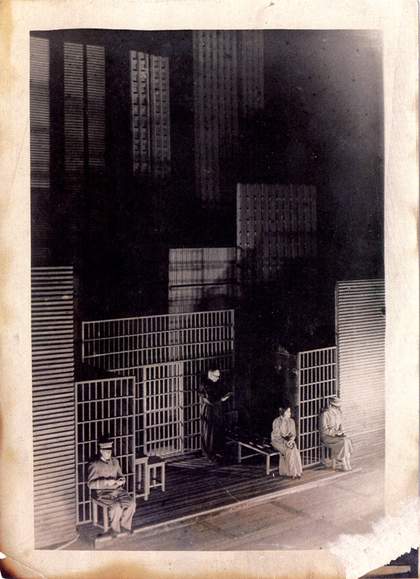
Fig.5
Vadim Ryndin
Scene from Machinal by Sophie Treadwell, Chambers Theatre, Moscow 1933
Gelatin silver print
24 x 14 cm
Private collection © The estate of Vadim Ryndin
Popova’s use of grids in theatre design survived on the Soviet stage until as late as 1933 when the anti-avant-garde zealots began to take charge of the Soviet art world. In the same year Vadim Ryndin built a series of lattices for Aleksandr Tairov’s production of Sophie Treadwell’s play Machinal (fig.5). Ryndin simplified the open geometric shapes typical of constructivism to the utmost degree, alluding indirectly to the similarity between the grid’s open geometries and a prison cage and thus endowing this abstract emblem of modernity with an ideological meaning relevant to the increasingly hazardous political climate. Paradoxically, in 1924, the year of Lenin’s death, the constructivist Gustav Klutsis had converted, for a political book cover design, an open cube structure derived from his street constructions for kiosks and tribunes, into a hard labour, capitalist prison, filled with despairing inmates.11 By the middle of the 1930s the grid disappeared from Soviet art, for its ‘antinatural, antimimetic, antireal’ properties contradicted socialist realism’s loyal service to mimetic representation. When the first generation of dissident modernists emerged in Moscow in the end of the 1950s, and adopted gestural expressionism in rebellion against the officially approved style, the grid, because of its association with materialism, science and logic, found no advocates. In the early 1960s, however, artists Lev Nusberg and Francisco Infante (founders of the Movement Group) recognised the value of science for the arts. They reintroduced the elements of the grid into two-dimensional works and aspired to realising Popova’s concept of organising public spaces through people’s interaction within the matrix of three-dimensional grids. Infante’s Galaxy 1967 exemplifies such effort: it is a monumental metal skeleton structure webbed with cloths-lines and was interactive. Remarkably, Infante managed to install it next to a Stalin-style neo-classical pavilion on the site of the Permanent Exhibition of the Achievements of the People’s Economy (in abbreviation VDNKh) (fig.6). Begun in the late 1930s and open during the whole Soviet era, VDNKh was a blend between socialist-style entertainment and a propaganda machine generating scenarios of the triumph of the country’s economy. The removal of Infante’s alien modernist edifice from this epicentre of the regime’s myth-making, ordered by the authorities only a few hours after the structure was completed, demonstrated that the grid had regained its status as modernity’s checkpoint.
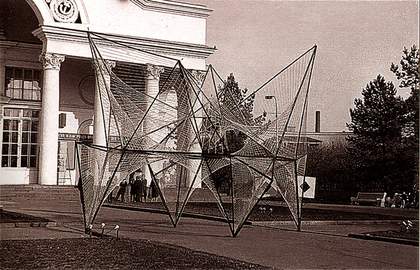
Fig.6
Francisco Infante
Installation view of ‘Galaxy’ at VDNKh, Moscow 1967
Gelatin silver print
5 x 10 cm
© courtesy private collection
In the 1970s the conceptual artist Ilya Kabakov departed from the grid as an untainted geometric structure. Unaware of Rodchenko’s practice of using non-objective constructions to deliver a verbal message, Kabakov, in an untitled small ink drawing, infested the grid’s inner structure with fragments of communal speech, such as ‘How much for what?’ and ‘Give it to me quickly’. Occupied throughout the 1970s with making albums (loose pages of texts and drawings stored in boxes), Kabakov monumentalised his model of the narrative grid ten years later in a series of mechanically painted (following Rodchenko’s monochrome triptych) white masonite works. In one of these panels, titled The Schedule for Taking out the Garbage Can, he reduced the function of the grid to the level of a bureaucratic chart recording collective participation in such repetitive and most mundane chores. (fig.7) In these, perhaps the artist’s most original two-dimensional works, he utilised the grid to replace a representation of reality by a construction of its inventory.

Fig.7
Ilya Kabakov
The Schedule for Taking Out the Garbage Can 1980
Enamel on masonite
150 x 210 cm
Kunstmuseum, Basel © Ilya and Emilia Kabakov, Courtesy Sean Kelly Gallery, New York
In such works Kabakov may have taken into account the way in which his close friend Erik Bulatov in the early 1970s had combined the grid with perspectival space, thus sort of traveling backwards in time to when, in Krauss’s words, Renaissance painters drew ‘perspective lattice on the depicted world as the armature of its organisation’.12 And yet as Bulatov’s seminal paintings Entrance 1972 and Skier 1971–4 (fig.8) demonstrate, he did not isolate himself in the distant past. Instead, he effectively confronted key spatial and conceptual taboos that twentieth-century modernists had assigned the grid to guard.
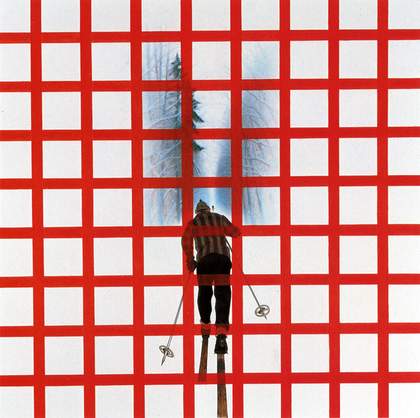
Fig.8
Erik Bulatov
Skier 1971–4
Oil on canvas
180 x 180 cm
Private collection, Bern © Erik Bulatov
In Entrance Bulatov mapped the canvas with a red grid and thus instantaneously endowed this visual structure with an ideological function. Furthermore, he did away with the grid’s stubborn two-dimensionality by inscribing the word ‘entrance’ at an angle and then twice more on each side of the painting. As if using words in repetition were not enough to destroy the silence of the grid, Bulatov painted an arrow between each pair of words, forcing the viewer’s eye to trespass through the grid’s bars, overcoming the grid’s ambition to freeze the viewer’s gaze on the surface of the canvas. In Skier, the painting that Bulatov took several years to finish, he uses the same red grid to define the borders of mimetic representation. Here the skier is moving away from the viewer towards a distant forest in pursuit of the tiny figure of another skier, drawing the viewer into the pictorial space as words and indexical arrows had done in Entrance. The grid responds to this assault by imprisoning its representational enemy and by compromising the viewer to the extent that he or she tolerates the elements of the real within the aesthetic field only if those elements are ‘locked behind bars’.
Ivan Chuikov, another important artist from the Moscow conceptual milieu, likewise appropriated a pre-modernist format of the grid – a window structure that served as a device to show a fragment of visual reality in a painting. And like Bulatov, Chuikov turned this tradition upsidedown in works in which he replaced a painted image of a window with a window-object where the spaces between the bars were opaque flat surfaces on which he rendered a representation of his choice. Adorned with imagined slices of reality, these fake windows become a panacea for the stagnating and agonising order of things beyond his secluded studio. Chuikov’s urge to erect the grid in the form of windows between his private aesthetic space and the mundane public one points to the constructivists’ failure to organise and ultimately aestheticise Soviet byt (daily life). Rodchenko’s 1926 cover design for Marietta Shaginian’s book Everyday Life and Art, has remained an emblematic advertisement of this utopian project of the post-Lenin era. On this unpublished maquette, the image of the new woman (modelled by Rodchenko’s wife, artist Varvara Stepanova) grins at the hopeful Soviet citizens through a grid of vertical white lines.
The marriage of formalism and politics has haunted the history of Russian art since the Revolution when avant-garde artists proposed using non-objective forms to serve political causes and disseminate political messages. It is owing to this persistent ambition to utilise the emblematic geometric structure within political discourses and contexts that the Russian grid has taken a rather different trajectory from that in the West. To illustrate this difference, in my book Against Kandinsky I offered a comparison between the earlier mentioned Ryndin’s stage props, derived from the constructivist morphology of the 1920s, and Sol LeWitt’s 1966 installation at the Dwan Gallery, New York, in which he inaugurated his serial approach to modular open structures. In his seminal project LeWitt forfeited the colour black that he previously applied along with white to paint similar structures because, as the art historian James Meyer has written, for LeWitt ‘black was too “expressionistic” … black still possessed the tragic associations invested in it by the abstract expressionists’.13 Thus, unlike Ryndin’s cage-like structures alluding to political repressions of the 1930s, and Bulatov’s red grids blatantly suggestive of the socio-cultural limitations of the 1970s, LeWitt made sure to fortify his three-dimensional grids from the intrusion of just such significations. His modular open structures operated solely through the function of the signifier becoming, in Meyer’s words, ‘the latest manifestation of the minimal look, the most uncompromising, the most radical reduction of all’.14 This distinction led to the fact that if in Western art ‘one of the most modernist things about [the grid] … is its capacity to serve as a paradigm or model for the antidevelopmental, the antinarrative, the antihistorical’,15 in Russian art the grid, through its marriage with factographic (the avant-garde)16 rather than narrative (realist or socialist realist) images, is open to change as it functions to map specific historical moments as outlined above.
Unlike the colour red that even today continues to carry political connotations, black was divorced from individual psychology (as promoted by Kandinsky after his return to Moscow),17 with the help of such artists as Malevich, Rodchenko and others who used it in an unemotional, mechanical mode. This made the colour black, like the grid, a checkpoint of modernity, and it reigned as such in the early 1950s in paintings by Robert Rauschenberg and Frank Stella. Can the colour black still take on that role and can it do so in alliance with the grid?
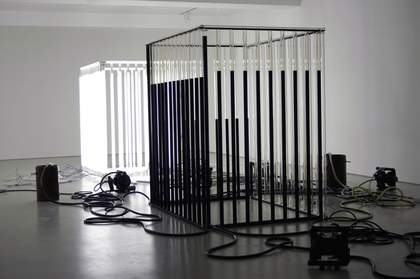
Fig.9
Andrei Molodkin
Installation view of Liquid Modernity 2009
Orel Art UK © Andrei Molodkin
Andrei Molodkin’s installation Liquid Modernity 2009 (fig.9) proposes a union that entails the grid’s ‘antidevelopmental’ characteristic (only as far as the grid’s insistence on repetition is concerned) that was brilliantly exploited by Piet Mondrian, as well as by Frank Stella who constructed his white grids over pitch-black canvases). Molodkin’s transparent acrylic tubes are filled with crude oil, which despite of being an inalienable part of ‘modernity,’ has never been mythologised by modernists. Futurists, for example, had used other, oil-mediated images such as aeroplanes and automobiles, but rarely has anyone represented oil as the blood that feeds modern infrastructure in fine art.18 Molodkin bares the skeleton of industrialisation as he imprisons oil in the Bastille of acrylic boxes or bars. The use of this organic matter in an art work gives it a status of colour that I would dub ‘liquid black’ (whose degree of blackness fluctuates depending on the origin of the oil, Russian being the darkest and the thickest), and gives to Molodkin’s cold structures the status of liquid grids. Just as cubist painting dissolved classical canons of representation, oil, as it penetrates insulated acrylic tubes with the help of loud pumps, liquefies the solidness of modernist grids. In this case the controlled (constructivist) and free (expressionist) artist’s hand is mechanised, resulting in yet another form of ‘machine art’.
If for the philosopher Peter Sloterdijk oil gushing from a well symbolised twentieth-century modernism, Molodkin’s oil grids can be seen as emblems of a current ‘liquid’ phase of modernity.19 Sociologist Zygmunt Bauman defines it as ‘a condition in which social forms (structures that limit individual choices, institutions that guard repetitions of routines, patterns of acceptable behaviour) can no longer (and are not expected) to keep their shape for long, because they decompose and melt faster than the time it takes to cast them’.20 Molodkin’s imprisonment of oil in transparent tubes (besides being a perfect opposite to Sloterdijk’s image of gushing oil) conveys a paradoxical characteristic of ‘liquid times’ that are both mutable and rigid. To a degree, it can be seen as a product of the collapse of the Soviet Union, whose macro-ideology by virtue of contradiction helped the West to promote itself as a pluralist, democratic and ethical society. However, as soon as this Cold War dichotomy was gone, the immeasurable wealth of the new Russians and their non-transparent ethics pervaded the hitherto unavailable space of their former opponent. This new order of things has made a lasting imprint on the post-Soviet Russian culture, leaving no space for radical art (unlike in the period of stagnation and even more during Perestroika) and making many artists shift from the Soviet conformity to a post-Soviet ‘flexibility’. In Bauman’s words, this new period is marked by ‘a readiness to change tactics and style at short notice, to abandon commitments and loyalties without regret – and to pursue opportunities according to their current availability, rather than following one’s own established preferences’.21 Within this social, economic and cultural viscidity (not so much political after Vladimir Putin replaced Boris Eltsyn), contemporary artists tend to dwell within the parameters of a false modernist consciousness. Among the most visible examples are, in my view, Anatoly Osmolovsky’s belated reading of Clement Greenberg’s writings in order to advance his own laboratory, rather than productivist, leftism, Dmitry Gutov’s similarly deferred deployment of Marxism to confront, if only scholastically, the unleashed rein of post-Soviet capital and hunger for hitherto unavailable commodities, and Oleg Kulik’s donning a curatorial mask to re-enact Soviet ‘communal modernism’.22
Unlike these artists who are engaged in the carnival of simulacra, Molodkin exhibits a modernist stubbornness with respect to his use of a specific medium and the message that it insistently and repetitively delivers. Molodkin’s stalwartness bothers some fellow artists and Russian collectors, for he reminds the former of their political indifference and prevents the latter from escaping into the world of pure aesthetics where there is no ‘odour’ of black gold.23 As Molodkin uses crude oil – material that has been fundamental to his country’s infrastructure, and even survival – to make his sculptures, he is engaging in a truly deconstructivist activity with respect to the social and political mechanisms of post-Soviet Russia.
In Liquid Modernity Molodkin’s adjoining of an open cube (saturated with oil and symbolising materialism) and a white one (made out of fluorescent tubes and symbolising idealism) speaks of the grid’s ability to encompass ‘the sacred and the secular’. His black and white cages critically allude to politicians’strategies of masking the link between oil and capital, and the veiling of their interest in oil-rich territories with the rhetoric of a higher purpose – be it the spread of democracy or the protection of religion. At the same time, Molodkin’s use of fluorescent tubes evokes Dan Flavin’s oeuvre, which is particularly relevant given Flavin’s series of works dedicated to Vladimir Tatlin, the patriarch of constructivism. Both Flavin and Molodkin exploit the extreme fragility of fluorescent tubes to create a sense of the volatility of cultural icons (Flavin) and of societal canons (Molodkin).
The modernist grid in its very structure is an opponent of mental and visual disorientation, and its subsequent marriage with documentary (factographic) material (made in Russia by constructivists and in Germany by the Bauhaus artists) changed the grid from being a structure of an ‘abbreviatory optic’ to being a tool for attaining what the Bauhaus artist Herbert Bayer called ‘the extended vision’.24 It calls for a constant flux of forms and media, and yet prescribes in order to preserve one’s system of thinking. Postmodern artists were the last to adopt collectively this second function of the grid, the paradigm of art making, now melting, like arctic glaciers, in the global space of political, economic, and social uncertainty.


